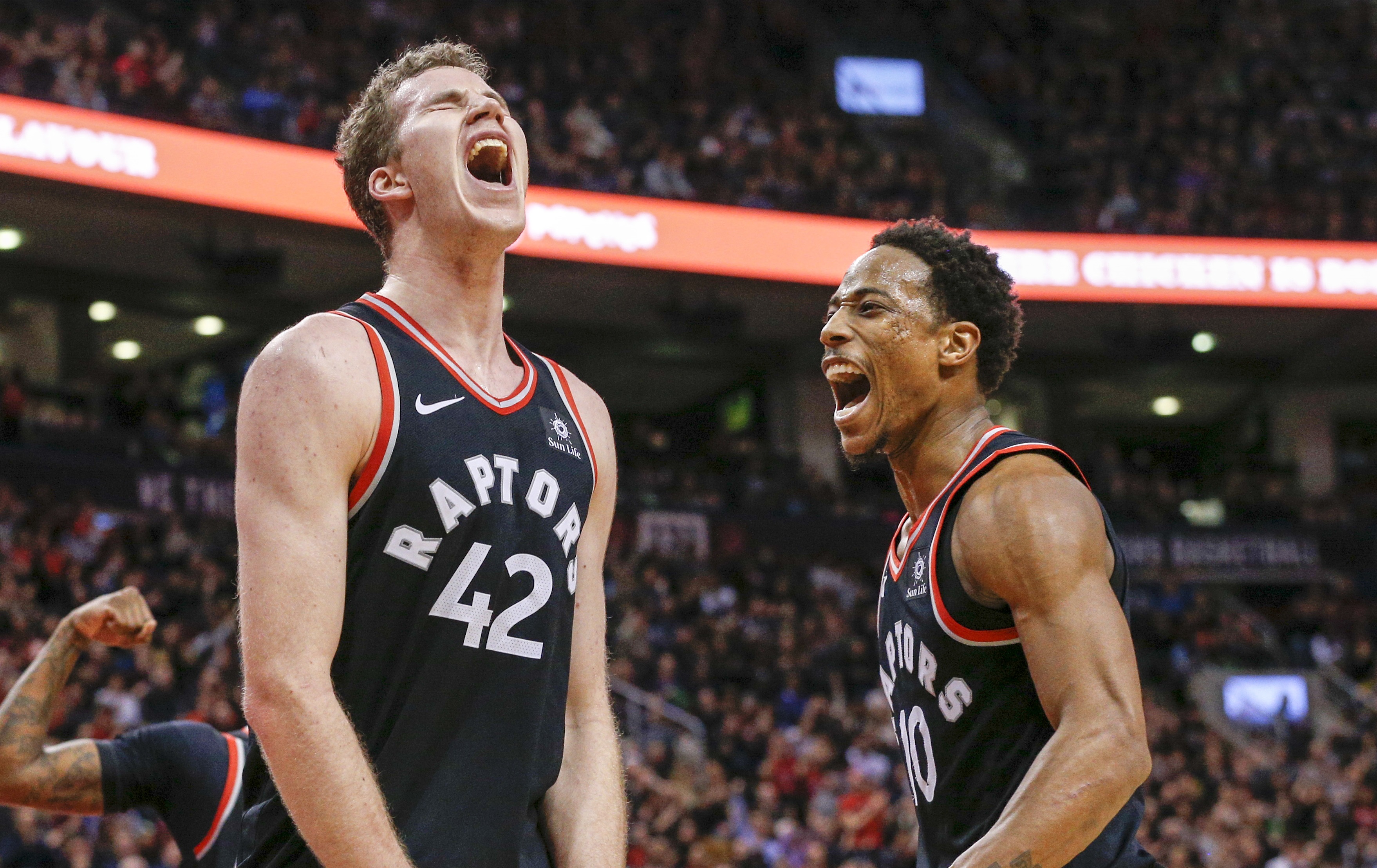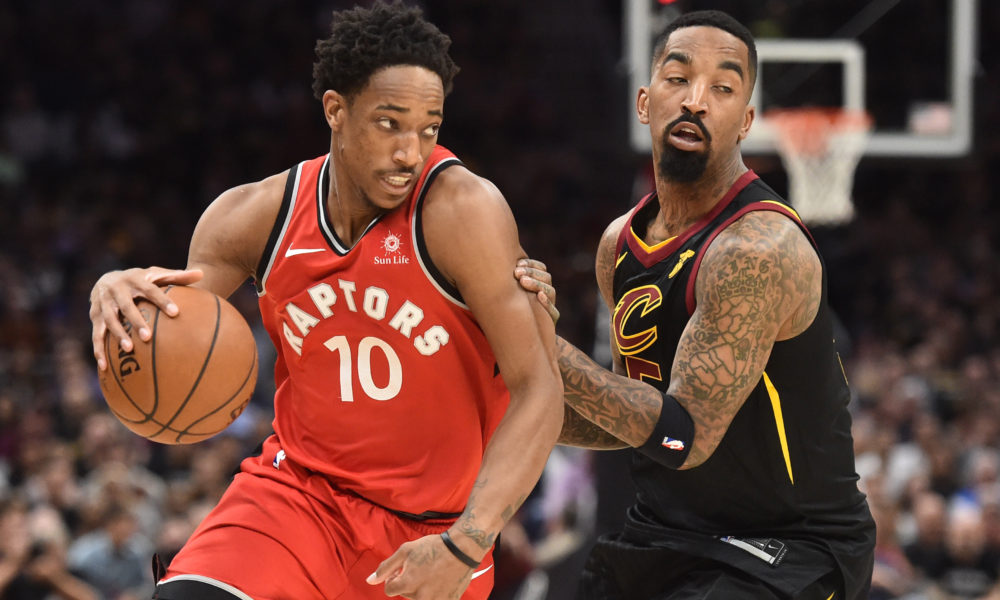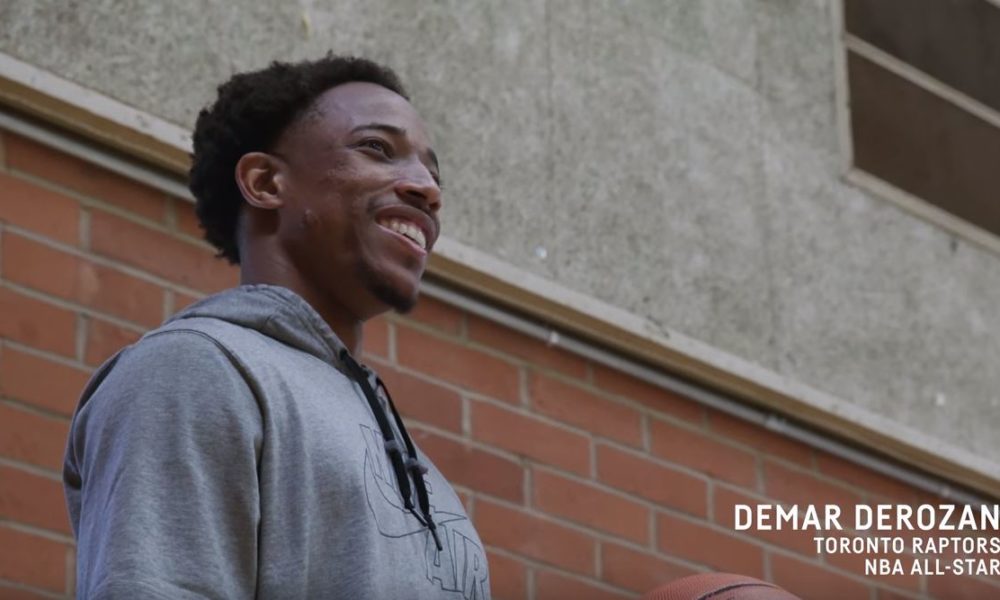You can keep up with all of our player reviews here.
Calm, thoughtful, self-aware. These are just some of the traits that come to mind when evoking the thought of the first-ever Austrian to play in the NBA.
Jakob Poeltl, just like the rest of the Toronto Raptors’ Bench Mob, had a stellar 2017-18 regular season. Entering the year, head coach Dwane Casey reasonably suggested that it would be up to Lucas Nogueira and the 22-year-old sophomore to battle for the right to backup starting center Jonas Valanciunas, but it didn’t take too long for Poeltl to make the position his. His chemistry with fellow Utah Ute Delon Wright has been there since Day 1, while the ability to complement Pascal Siakam’s game perfectly added another unique dimension to the way the reserve unit sliced teams up.

There was his first double-double of the season against the San Antonio Spurs on the road, in which he showed out against All-Star LaMarcus Aldridge and a man whose game he believes he can emulate, Pau Gasol. He finished with 10 points and 12 rebounds, four coming on the offensive glass, and three blocks to boot.
https://www.youtube.com/watch?v=H44qeAyndZk
If that wasn’t impressive enough, he racked up another double-double against the Golden State Warriors just two days later that included 11(!) offensive rebounds. He was able to take advantage of the smaller Warriors lineups and exposed a weakness in their style of play that we saw the Houston Rockets make maximize most recently.
Notably, both games came with extra minutes courtesy of the absence of Valanciunas. The Raptors matched the length of the Spurs’ frontcourt by starting Nogueira alongside Serge Ibaka, while Siakam got the nod to increase their foot speed against the defending champions.
Other memorable performances included a perfect 18-point outing on 8-for-8 shooting against the Indiana Pacers on Dec. 1 and 12 points, 12 rebounds and three blocks against the Cleveland Cavaliers in that 133-99 rout at the Air Canada Centre on Jan. 11.
*Jack Armstrong voice*
Get that GAHBAGE outta here! https://t.co/65WanBCRin
— Toronto Raptors (@Raptors) January 12, 2018
There was a 13-point, eight-rebound, five assist performance against the Orlando Magic, and another showcase of his ability on the offensive glass against the Cavs with 17 points and seven offensive rebounds in a 132-129 road loss.
A crucial part of Poeltl’s success on the offensive end stemmed from his ability to make quick reads and use his quick feet to get to the right spots either after setting a pick or diving in from the weakside. This may not sound like anything groundbreaking for a big with good touch around the basket, but what shifts the goal posts in terms of his potential is the ability to read the defense to make better plays for the team’s offense.
Picture the scene: Delon Wright has the ball at the top of the arc and calls for a screen on the right side. Poeltl sets it perfectly, before taking off for the rim. As Wright maneuvers his way past his man, he finds the cutting big. But, he doesn’t make the pass because Poeltl’s open. Rather, he’s making the pass because he knows the man in the weakside corner — who he doesn’t quite have the angle to get the ball to — is wide open. Poeltl catches the ball and in one fell swoop, swings the ball to the corner for an open three-pointer. I haven’t verified the analytics on this play, but the eye test suggests that 80 percent of the time, it works every time.
“We work on that a lot,” Wright told Raptors Republic back on Feb. 23 before a game against the Milwaukee Bucks. “Just hitting the roller and letting him make a play, not always trying to do all the work… In college he was more of a throw it in the post and score it while here we try to hit him on the roll. It’s different styles and speaks to his ability to do both.”
The Raptors haven’t explored that side of Poeltl’s game yet, what with all the touches that go around to the more senior members of the team. But, with his ability to see the floor, it points to another wrinkle that the team could add to their offensive repertoire over the years to come especially when considering his willingness as a passer and desire to generate the best look for the team. Now, there will likely be growing pains of him learning to play through contact and eventually even double-teams, but as we have seen throughout this postseason, there is marked value in a player possessing an individual level of gravity and getting the team a bucket when things are a little bit out of sorts.
Defensively, Poeltl has shown both good and bad. He can be very sneaky and pick up big blocks, but his biggest asset remains defending the pick-and-roll. That should continue to be so in the pace-and-space era, and the deflections and steals the Toronto bench was able to convert into transition scoring was a key component of their success all season. That starts with pressuring the ball at the point of attack, something aided by having a big who can exceed the expectations of an average center.
“Just the way the game is going, with bigs being able to move and be agile, I think that that helps him, he’s light on his feet and can move,” Wright said. “I’m able to be more aggressive knowing that I have him behind me.”
Where Poeltl can stand to improve is his help-defense inside and rebounding as a result. As someone who is so predicated on helping his team and his trusting those on the court with him to do the same, Poeltl was often seen leaving his man to contest a shot or present a body after a teammate got beat. Unfortunately, for him, the desired rotations thereafter seldom happened and so unless Poeltl was able to successfully impede the progress of the opposing player, his initial man was either left with an easy finish off a pass or offensive rebound.
Toronto’s all-bench unit received much of its deserved praise due to a plus-17.1 net rating over 340 regular season minutes, and this is all the more impressive when considering they did so with a defensive rebound percentage of 73.8. Contrast that with the 82.5 defensive rebounding rate of the starting unit or even the 77.7 rate for the team as a whole, and it becomes easier to recognize just how much of an opportunity for improvement there is here.
It’s obviously unfair to pin it all on one player, as his teammates doing a better job of preventing dribble penetration or rotating over once he offers help can negate a lot of the bad that happens. He’s smart enough and quick enough to play cat-and-mouse with the ball handler, so it’s a question of giving him the best opportunity to do so, too. A lot of the time right now, though, it’s almost as if he tries to be too perfect with his help, demanding that whoever is responsible for helping the helper has to be in perfect harmony with him. The Raptors’ chemistry is great, but not everyone is BFF Siakam.
Poeltl became more exposed towards the end of the regular season when teams attacked him with size and strength; the L.A. Clippers turned to Boban Marjanovic in a fourth quarter run that turned the game on its head, while Oklahoma City Thunder center Steven Adams had his way with the Austrian in a Sunday matinee showdown. Strength will be a vital aspect of Poeltl’s improvement for next season, but he’s got to be mindful of not doing so at the expense of his mobility.

The playoffs — beyond some surprising success at the free-throw line — will be looked upon as an abject failure for the 22-year-old. His foul-prone ways became even more prominent and diminished success finishing around the rim impacted his productivity as well. The heightened physicality highlighted just how much he needs to gain in the strength department, while the foul trouble will hopefully dissipate some with lessons learned from experience but also just a bit more respect from the officials.
There’s no doubt he will have expected more of himself, but it’s important to keep in mind that this was his first taste of meaningful postseason minutes. Was he quite as unplayable as the last few games against Cleveland seemed to suggest? Perhaps not, but it’s likely the lack of playing time will only further his resolve to come back at a higher level in his third year.
The Raptors are taking their time to figure out who the right man is to have at the helm of a group littered with veterans and young developing players alike, and that decision may have just as much impact on what we see from Poeltl in Year 3 as the time he puts into developing his own game over the summer. No matter how it shakes out, though, the organization can be certain that a player with a mature head on his shoulders and talent to match will find a way to make the most of whatever he’s given.



